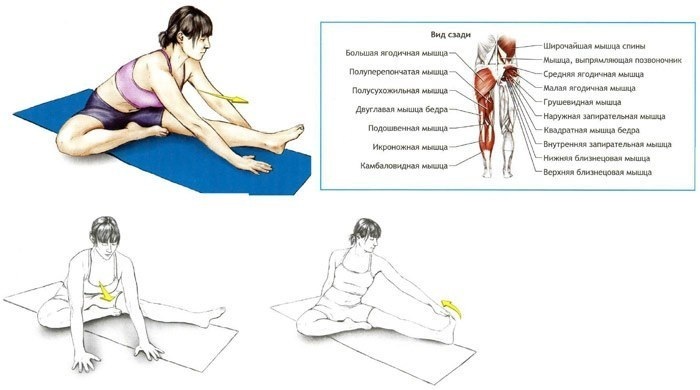Inflammation of the tendons of the knee joint is called tendinitis in medicine. The disease is accompanied by characteristic symptoms. The main cause of the pathology is heavy loads on the lower extremities.
The inflammatory process develops as a result of the occurrence of microtraumas of the tendons of the knee joint. A traumatologist is involved in diagnostics and treatment. Timely examination and correctly selected therapy will help prevent serious complications.
Record content:
- 1 Views
- 2 Stages and degrees
- 3 Symptoms
- 4 Reasons for the appearance
- 5 Diagnostics
- 6 When to see a doctor
- 7 Prophylaxis
-
8 Treatment methods
- 8.1 Medications
- 8.2 Traditional methods
- 8.3 Other methods
- 9 Possible complications
- 10 Tendinitis videos
Views
Knee tendon inflammation occurs at any age, but professional athletes, children and adolescents, and people over the age of 40 are more often at risk.
In medicine, there are the following types of tendonitis:
| Name | Description |
| Spicy | Disease of the knee joint begins acutely and is accompanied by a pronounced clinical picture. Distinguish between aseptic (non-infectious) and purulent (infectious) acute tendonitis. |
| Chronic | The inflammatory process in the area of the knee joint is sluggish and is characterized by mild manifestations. The period of exacerbation is replaced by remission. |
Tendinitis causes weakness and reduces the mechanical strength of the patellar ligaments. A complication of pathology can be partial or complete rupture.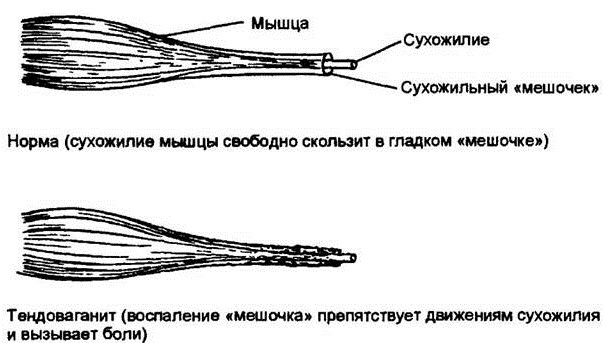
Given the area of the lesion by the inflammatory process, the following classification of the disease is also distinguished in medicine:
| Name | Description |
| Tendinitis | Tendons are affected by the dystrophic-inflammatory process. |
| Tenosynovitis | The tendon sheath becomes inflamed. |
| Tendosynovitis | The inflammatory process spreads to all tendon tissues. |
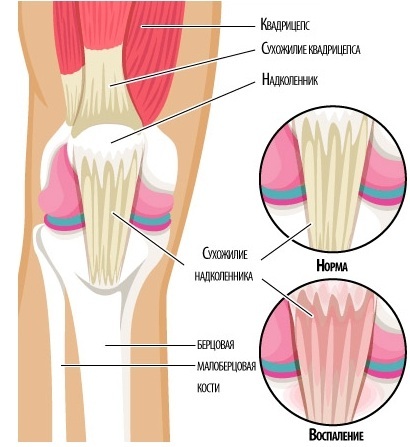
Any form of inflammation is accompanied by characteristic clinical symptoms. A traumatologist will help to establish an accurate diagnosis; it is important to go to the hospital in a timely manner and undergo an examination.
Stages and degrees
Given the course and spread of the inflammatory process, knee tendinitis develops in stages:
| Name | Description |
| Stage I | Reactive tenosynovitis. Joint tissues adapt to damage. The functioning of the knee is satisfactory, painful sensations appear only after physical exertion. Timely therapy will allow you to fully recover without consequences. |
| Stage II | The inflammation progresses, the patient complains of pain after minor physical work. |
| Stage III | Pathological changes provoke strong painful sensations that disturb a person even at rest. |
| Stage IV | Knee tendon inflammation progresses and increases the risk of patellar ligament damage. The strength of the tissues decreases, so a slight load can provoke a rupture. |
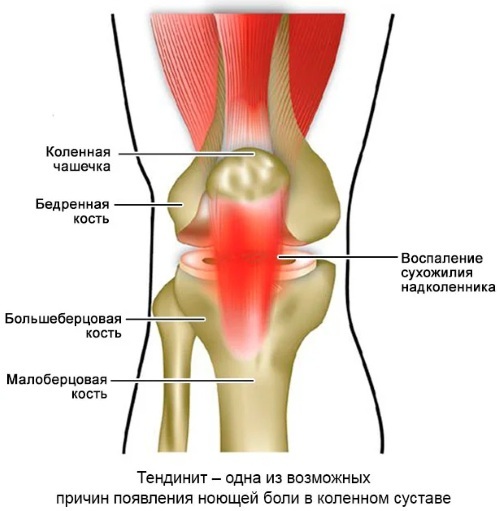
At each stage, characteristic clinical symptoms appear, with which it is important to consult a traumatologist in a timely manner. The specialist, taking into account the patient's complaints, will establish the stage and degree of development of tendonitis.
Symptoms
Inflammation of the tendons of the knee joint (treatment is prescribed by a specialist after a complete diagnosis based on the results obtained) is accompanied by characteristic clinical symptoms. The manifestations of the disease will help the traumatologist to establish a preliminary diagnosis and prescribe the most informative comprehensive examination.
Knee tendinitis is accompanied by the following clinical symptoms:
- severe pain in the knee area;
- reduced mobility of the affected joint;
- a squeak is heard during movement of the injured limb;
- tissues in the affected area swell and turn red;
- increased sensitivity to palpation.
The main symptom of inflammation of the tendons of the knee joint is pain syndrome, which makes it possible to determine the area of localization of pathological processes.
Reasons for the appearance
A common cause of knee tendinitis is heavy stress on the lower extremities. The tendons are damaged under the influence of constant pressure, against which an inflammatory process appears.
There are numerous provoking factors that trigger pathological changes:
- intense load during sports activities (running, jumping, climbing stairs);
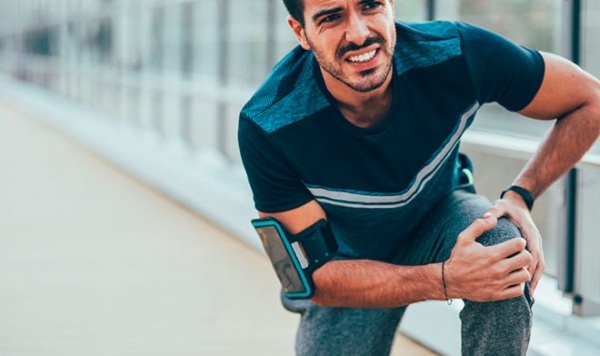
- injury or trauma to the knee joint;
- pathological movement of the lower limb;
- flat feet;
- decreased elasticity of the thigh muscles, their weakness;
- extra pounds, obesity;
- a sharp increase in physical activity;
- increasing the intensity of training;
- an allergic reaction to certain medications;
- bacterial or fungal infection of the body;
- age-related changes;
- parasitic damage to the body;
- deterioration of immunity;
- concomitant diseases (diabetes mellitus, renal failure, gout, arthritis);
- congenital or acquired deformity of the spinal column.
Due to anatomical features, women are more likely to experience inflammation of the tendons of the knee joint, due to wide hips. The symptoms of the disease cannot be ignored, since a progressive inflammatory process will lead to the occurrence of degenerative-dystrophic changes. Not only will the functioning of the tendons be impaired, they will begin to collapse.
Diagnostics
The diagnosis and treatment of inflammation of the tendons of the knee joint is carried out by a traumatologist. The specialist will conduct an examination, taking into account the patient's complaints, prescribe a comprehensive examination in order to make an accurate diagnosis.
The following methods are used to identify the inflammatory process: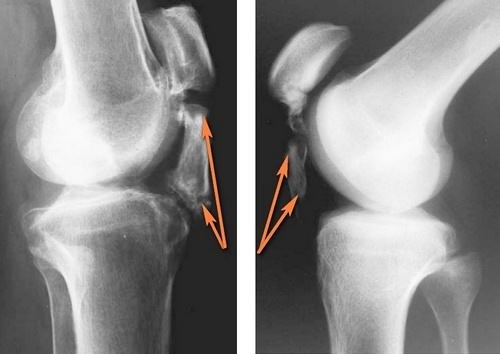
| Name | Description |
| X-ray | A diagnostic method that allows you to establish the site of localization of the inflammatory process of the tendons and exclude damage to the bone structures. |
| Magnetic resonance imaging (MRI) | A multi-layered examination method, with the help of which the specialist examines the entire area of the knee joint. |
| Ultrasound procedure | Diagnostic method that allows you to view the knee joint and the surrounding tissue. |
| General analysis of blood and urine | Laboratory tests are necessary if there is a suspicion that tendonitis has caused an infectious lesion in the body. The same goes for the rheumatoid process. |
It is important to differentiate the disease, since many pathological changes are accompanied by similar clinical symptoms.
When to see a doctor
Consultation of a traumatologist and examination of the patient will be needed when the first clinical signs of an inflammatory process appear. The symptoms of tendonitis cannot be ignored, since progressive pathological changes entail serious consequences and complications.
Prophylaxis
It is possible to prevent inflammation of the tendons of the knee joint if you remember the simple recommendations of a traumatologist:
- Warm up before any physical activity.
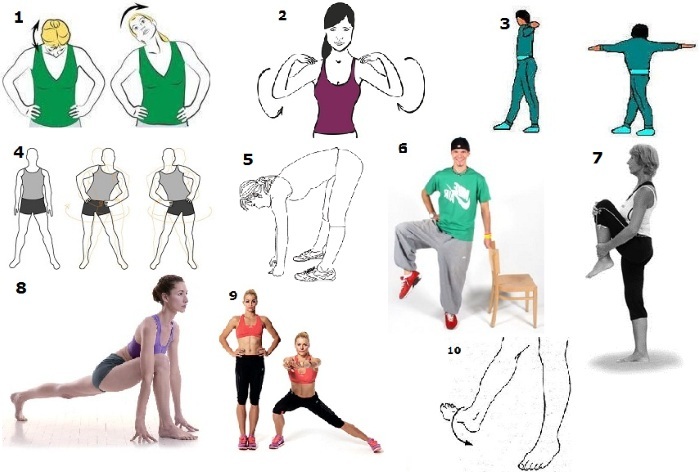
- When lifting heavy objects, bend your knees.
- Perform sports exercises with frequent changes in muscle groups.
- Avoid sudden movements.
- Increase the load gradually.
- Lead a healthy and active lifestyle.
- Eat correctly and rationally, control body weight.
- Give up bad habits (abuse of alcoholic beverages, tobacco products).
As a preventive measure, it is recommended to promptly treat various diseases or injuries, against which an inflammatory process may appear in the area of the tendons of the knee joint.
Treatment methods
Treatment of inflammation of the tendons of the knee joint is carried out using complex methods. Patients are prescribed medications, in addition, in the absence of medical contraindications, folk remedies can be used.
During the rehabilitation period, patients are advised to attend physiotherapy procedures. In emergency or serious situations, surgery is indicated.
Medications
Medicines are selected by a traumatologist, guided by the results of a comprehensive diagnosis. The individual characteristics of the patient's body, his condition are also taken into account. It is important to adhere strictly to the treatment regimen and dosages, since many drugs provoke side effects.
Knee tendonitis involves the following medications:
| Drug group | Name | Application |
| Non-steroidal anti-inflammatory drugs | Ibuprofen, Naproxen | Medicines reduce inflammation and pain. The tablets are recommended to be taken orally with meals. The adult dosage is 400 mg 3 times a day. The course of treatment lasts 2-3 days. The time interval between doses should not be less than 6 hours. |
| Topical products | Capsicam, Nikoflex | Medicines reduce pain. The gel is applied to the affected area 1-3 g 2-3 times a day, rubbing in with light massage movements. The course of treatment lasts 10 days. |
| Corticosteroids | Diprospan, Flosteron | The medicine is administered intramuscularly or intraarticularly. The recommended dosage of the drug depends on the patient's condition and is 1-2 ml every week. The course of treatment lasts at least 4 weeks. |
| Angioprotectors | Troxevasin, Venitan | The drugs improve blood circulation in the area of the injured knee joint. It is recommended to take orally with meals 1 capsule 2 times a day, morning and evening. Supportive therapy involves taking 1 capsule per day for 3-4 weeks. |
| Vitamin complexes | Retinol, ascorbic acid | The medicine is taken in the morning or before bedtime after a meal in 10-15 minutes. The recommended dosage for adults is 50,000 IU 1-2 times a day. |
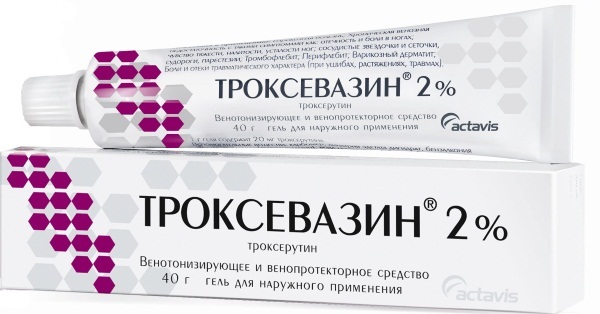
Special fixing accessories (orthosis, bandage) will help to relieve pain and discomfort. To strengthen the musculoskeletal system, it is also recommended to take mineral complexes (Arthrivitis).
Traditional methods
Prescriptions of healers and healers are used exclusively in complex therapy with medications. It is impossible to eliminate inflammation with folk remedies alone. It is also important to discuss therapy with your doctor, as the ingredients used can trigger an allergic reaction or individual sensitivity.
Inflammation of the tendons of the knee joint (treatment is selected in each case individually, taking into account the degree and stage of development of pathological processes) help reduce the following effective remedies:
| Name | Recipe | Application |
| Ginger | Grind the root of the plant and boil it with boiling water (300 ml). Soak in a thermos for 60 minutes and strain well. | The finished medicine is recommended to be taken orally for tendinitis of the knee joint, 100 ml 3 times a day. |
| Aloe | Wash fresh leaves of the plant well, dry and leave in the refrigerator for a day. Grind and squeeze the juice. | The resulting solution from the plant is recommended to be used for compresses. Moisten the bandage in aloe juice, apply to the affected joint and wrap it up. Leave the compress for 3 hours. On the first day, it is recommended to do the compress 5 times. Starting from the second day, 1 time before bedtime. |
| Walnuts | Pour 1 tbsp. walnut partitions with vodka (500 ml). The resulting product must be kept for 18 days. | Ready tincture is recommended to be consumed orally with inflammation of the tendons of the knee joint, 1 tbsp. 3 times a day. |
| White clay | The clay must be diluted with water to obtain the consistency of sour cream. | The resulting mass is rubbed into the injured knee. Cover with warm material and leave for 20 minutes. Then wash off with warm water. |
| Elecampane | Grind the root of the plant and pour 2 tbsp. hot water (2 tbsp.). Put the resulting mass on medium heat and heat for another 4-5 minutes. The broth should be infused for 2-3 hours, then strain. | Moisten a small piece of gauze in the resulting solution and apply to the sore joint. Bandage and leave for 2-3 hours. Elecampane reduces inflammation and promotes the restoration of damaged tissues. |
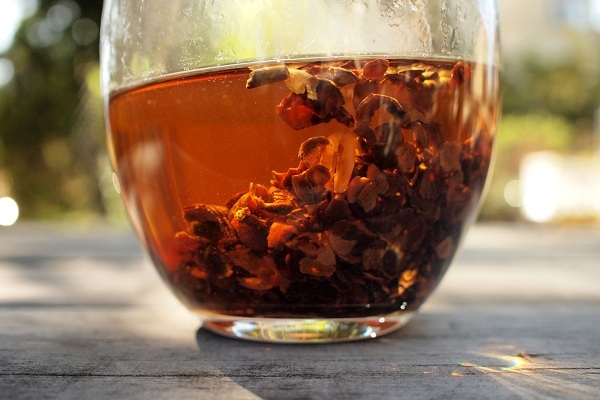
Turmeric helps to reduce soreness and inflammation in the knee joint. It is necessary to add seasoning to dishes by 0.5 g.
Other methods
Inflammation of the tendons of the knee joint (treatment is selected by a traumatologist, guided by the results complex examination) requires complex therapy and provides for the implementation of physiotherapy exercises patients. Exercises can be done after the swelling subsides and the pain syndrome decreases.
Gymnastics will improve the mobility of the joint, reduce the amount of fluid in it. The motor functions of the knee are also restored.
The set of exercises is selected by a physiotherapist, taking into account the person's condition and the individual characteristics of his body:
- You need to lie on your side and try to raise both legs in this position. The exercise should be repeated 5 times with short breaks. It is recommended to increase the load and the amount of exercise sequentially.
- You need to lie with your back on a flat surface. Raise one leg at a right angle and lower. Perform the exercise 5 times, then change the leg.
- Standing with your back to the wall, you need to squeeze the ball with your knees.
- In a seated position, it is recommended to bend and unbend the legs at the knees.
- While standing, perform swings with bent and straight legs, alternating them. Slowly increase the range of motion.
Therapeutic exercises are recommended to be performed 2-3 times a day, starting with minimal loads and gradually increasing them.
In the complex therapy of knee tendonitis, they are also used physiotherapy procedures after the exacerbation period has passed: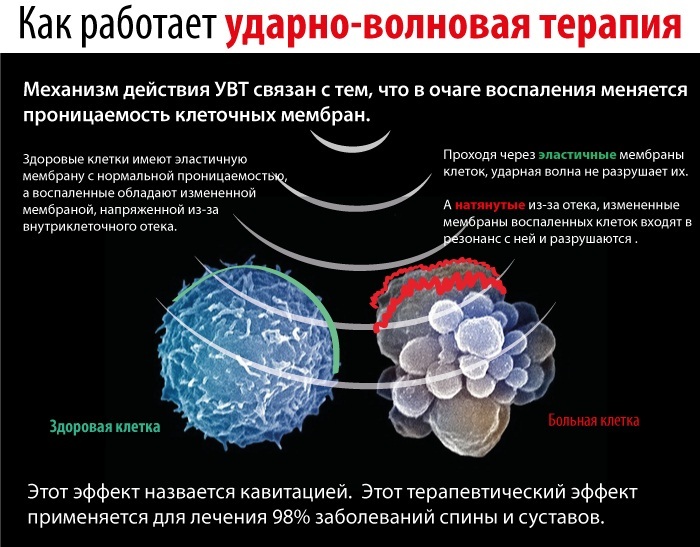
| Name | Description |
| Shockwave therapy | Sound waves are used during the treatment. They activate the growth of blood vessels and nerve endings. Therefore, the regeneration of damaged tissues is enhanced. |
| Magnetic therapy | Magnetic field therapy improves blood circulation in the affected joint area and reduces soft tissue swelling. |
| Medicinal electrophoresis | During the treatment of tendonitis, electric currents are used, under the influence of which the active components of medicinal preparations quickly enter the focus of the inflammatory process. |
Additionally, patients with inflammation of the tendons of the knee joint are prescribed paraffin applications, cryotherapy and UHF alternating current therapy.
In the case when drug therapy has not yielded a positive result or in emergency situations, surgery is indicated for patients with knee tendinitis.
Surgical treatment is carried out by the following methods:
| Name | Description |
| Arthroscopy | Medical manipulations are carried out through small holes made in the knee joint area. The surgeon removes the damaged tissue. |
| Open operation | Through an incision in the knee, the surgeon gains full access to the joint. |

The formation of cysts in the cavity of the knee joint or other degenerative changes against the background of the inflammatory process requires an open surgical intervention. After surgical treatment, the patient will have a long rehabilitation period, during which all the recommendations of the attending physician should also be strictly observed.
Possible complications
Complications with inflammation of the tendons of the knee joint in the patient will arise if medical assistance was not provided in a timely manner. Progressive pathological changes increase the symptoms of the disease and cause serious discomfort, disrupting a person's usual lifestyle.
Inflammation of the tendons of the knee joint (treatment is carried out under the supervision of a traumatologist after a comprehensive diagnosis) without proper therapy ends with the following complications:
| Name | Description |
| Tendon rupture | Increased and constant physical activity negatively affects the condition of the ligaments. Tissues weaken and become thinner, microtrauma leads to their rupture. |
| Lameness | Severe pain syndrome of a chronic nature interferes with normal movement, so the patient is forced to limp. |
| Disability | As the inflammation progresses, the tendon tissue becomes thinner. The risk of rupture increases. Physical activity decreases and the risk of disability increases. |
A poorly reconstructed joint or improperly selected therapy leads to the occurrence of chronic pathologies of the musculoskeletal system. You cannot engage in self-therapy, since you can not only harm, but also provoke serious consequences (loss of motor functions).
Inflammation of the tendons of the knee joint does not threaten the patient's life, but the lack of proper treatment will lead to irreversible degenerative-dystrophic changes. The quality of life of a person and his ability to work are violated. Therapy should be carried out under the supervision of a traumatologist, completely, excluding self-treatment.
Tendinitis videos
Doctor about knee tendonitis:


